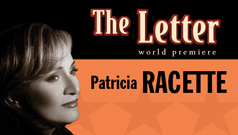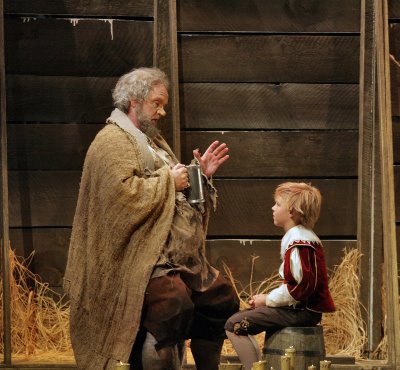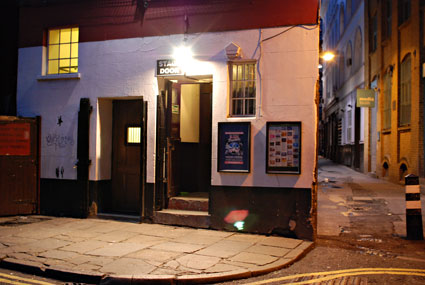 The Letter continues to move smoothly toward its July 25 opening night in Santa Fe. So far the only bump in the road has been a last-minute cast change that caused a certain amount of inescapable anxiety, though Paul Moravec and I now expect the outcome to be wholly gratifying. What’s more, our first opera is starting to stir up buzz in the small world of high culture. The June issue of Opera News and the May/June issue of Opera Now both contain flattering articles about The Letter (neither, alas, available on line as yet, though we’re hoping).
The Letter continues to move smoothly toward its July 25 opening night in Santa Fe. So far the only bump in the road has been a last-minute cast change that caused a certain amount of inescapable anxiety, though Paul Moravec and I now expect the outcome to be wholly gratifying. What’s more, our first opera is starting to stir up buzz in the small world of high culture. The June issue of Opera News and the May/June issue of Opera Now both contain flattering articles about The Letter (neither, alas, available on line as yet, though we’re hoping).
The Opera News piece, written by Barry Singer, goes into detail about an aspect of The Letter of which Paul and I are especially proud:
Though Santa Fe’s commission was initiated two years ago, The Letter now stands as an unexpected object lesson for navigating opera’s impecunious future. Clocking in at a mere ninety minutes in length (divided into eight scenes), with a cast of seven principals, plus supernumeraries and choristers totaling nineteen in number, The Letter cost a relatively meager $2 million and change to bring to the stage.
“It now can be done again and again,” acknowledges Charles MacKay, Santa Fe’s new general director, who inherited The Letter from his predecessor, Richard Gaddes. “It sure is a blessing for me–and such an intimate scale will enable other companies to do it too, in time. Extravaganzas like [John Corigliano’s] Ghosts of Versailles don’t have that chance. They’re hostages to fortune.”
Needless to say, neither of us foresaw that the American economy would tank when we started planning The Letter in the summer of 2006, but our decision to keep our first opera lean and mean is looking more prescient by the day.
 Paul and I also turned up in a preview piece about summer classical-music festivals that ran in the Sunday New York Times a couple of weeks ago. And Opera Today, an online magazine, ran a flattering profile of Anthony Michaels-Moore, one of the stars of The Letter, that sheds further light on the kind of opera that we sought to write:
Paul and I also turned up in a preview piece about summer classical-music festivals that ran in the Sunday New York Times a couple of weeks ago. And Opera Today, an online magazine, ran a flattering profile of Anthony Michaels-Moore, one of the stars of The Letter, that sheds further light on the kind of opera that we sought to write:
Moravec has written a lot of orchestral and chamber music but this is his first opera, and he wanted to involve his singers from the start. Michaels-Moore (who sings regularly at the Met) met the composer in New York, who asked him what he particularly liked in the music he sang. “Right!” said Moravec, “we’ll do it that way.” Because he writes with the singers, details can be tweaked and adapted, even in rehearsal. It’s very creative. Moravec also consulted Patricia Racette, who will sing Leslie Crosbie, the scheming wife. The result is an opera which “sings” well, and is user-friendly in performance. This could make it a regular part of the repertoire.
As for Opera, England’s highbrow opera monthly, the July issue will contain an essay called “Making an Opera Noir” in which I revisit some of the ideas that I’ve been discussing in this space since I started blogging about The Letter two years ago:
I enjoy many kinds of operas, including some, like Capriccio, Four Saints in Three Acts, and The Midsummer Marriage, that are not at all like The Letter. But The Letter is the kind of opera that Paul and I both wanted to write, a taut, compact repertory-style melodrama devoid of Big Ideas–the passionate emotions of the characters are its subject matter–that is aimed not at connoisseurs or intellectuals but at ordinary operagoers.
All this publicity notwithstanding, I don’t think that I’ve fully taken in the fact that The Letter will be opening in just fifty-five days, and I doubt that it will seem completely real to me until I fly to Santa Fe on July 12 to attend the last two weeks of rehearsals.
To be sure, I’ve already written an essay called “A Critic Takes a Bow” for the July/August issue of Commentary in which I speculate on the effect that writing The Letter will have on my work as a drama critic:
The practical lessons that I have already learned from writing an opera libretto are likely to stay with me for a very long time, and I expect to learn even more about what the playwright Alan Ayckbourn has called “the crafty art of playmaking” as I watch The Letter take shape in Santa Fe later this month.
Above all, though, I will learn how it feels to go in front of an audience and solicit its approval, and I may well find out what it feels like not to get it. Either way, I will surely come home a wiser man–and, I hope, a better critic.
 So I hope! But the truth, of course, is that I won’t really know what it feels like to put a brand-new work of art in front of an audience until the fateful day when I pass through the stage door of the Santa Fe Opera, step in front of the footlights, and face a theater packed full of people who paid good money to see The Letter. Will they cheer? Will they boo?
So I hope! But the truth, of course, is that I won’t really know what it feels like to put a brand-new work of art in front of an audience until the fateful day when I pass through the stage door of the Santa Fe Opera, step in front of the footlights, and face a theater packed full of people who paid good money to see The Letter. Will they cheer? Will they boo?
Right now I’m too busy with Pops: A Life of Louis Armstrong and my theater-related travels for The Wall Street Journal to lose much sleep over The Letter–but I expect that to change as July 25 draws nearer. Any artist who tells you that he’s serenely indifferent to such matters is a liar.
